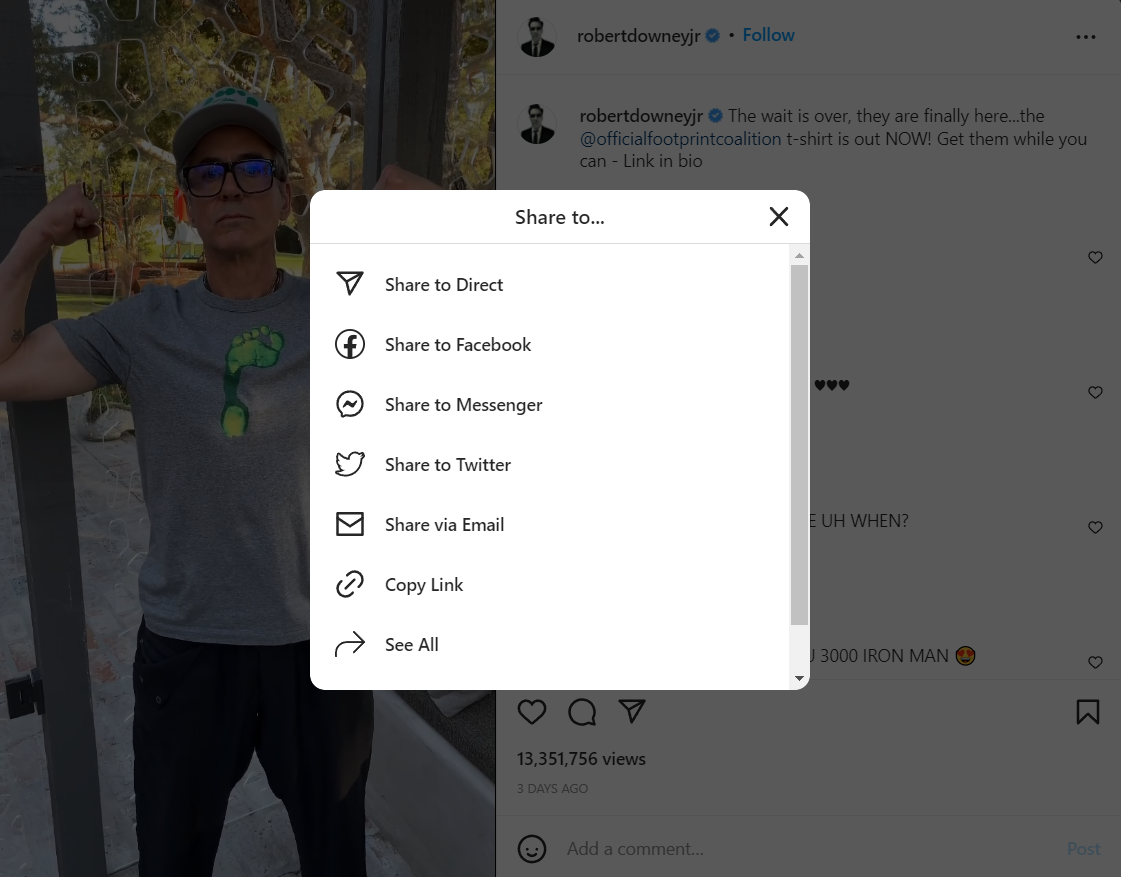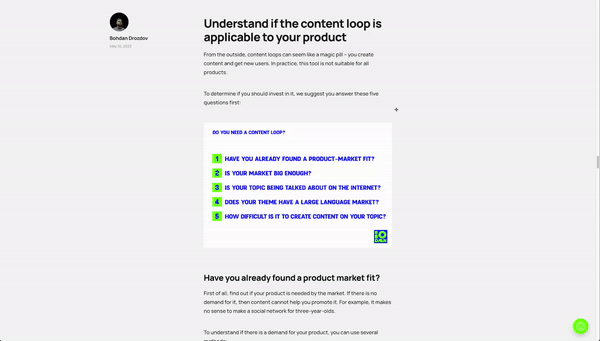How to get the most out of content loops: the ultimate guide

Content has long ceased to be just entertainment. Now, it is a tool that allows you to attract users, increase profits, and grow your business.
However, creating that content is only a small part of the task. If you want your content to spread like a hurricane, you need to make a real effort. But trust me, it's worth it.
In this blog post we will talk about content loops: what they are, what different types there are, and why you should use them. You will also receive a step-by-step guide to help you create a content loop for your business.
What is a content loop and how does it work?
Content loops involve publishing and sharing media, which is then shared by the business, its users, or partners. That action triggers signups, activations, and user engagement, which leads to more sharing of the media. This completes the loop or cycle.
A basic content loop looks like this:
- New users sign up and try the product.
- Content is created by users, companies, or partners.
- Content is distributed by users, companies, or partners.
- Content attracts new users who sign up and try the product.
For example, a user signs up for Pinterest. He adds his photos and pins them on a board. Algorithms show this board to those who might be interested in it. Another user finds a photo on Google, follows the link to the site, registers, and creates his/her boards.

The primary constraints of content loops are the costs and volume of content being generated and the return per piece of content. If the users are creating the content, the cost is lower, so you don’t need a big return per piece of content to make a content loop. But if the company is creating content, the cost is higher, which means you need a higher return for every piece of content.
Depending on these indicators, four types of content loops are distinguished. Next, we will analyze them in more detail.
4 types of content loops
The content loop varies according to who creates the content and how it is distributed:
- User-generated, company-distributed (UGCD);
- User-generated, user-distributed (UGUD);
- Company-generated, company-distributed (CGCD);
- Company-generated, user-distributed (CGUD).
UGCD Content Loop
Users create content through product usage that attracts more users. Search engines are most often used for the distribution channel.
In general, the scheme of UGCD content loop looks like this:
- New users sign up.
- Some users create unique content.
- Search engines index content.
- People find content by keywords.
- Some of them sign up.

Yelp is a website for local services, such as restaurants or hairdressers, with the ability to add and view ratings and reviews of those services.
A user signs up for a product by selecting a restaurant for a Friday night. He looks at the ratings of nearby establishments, reads the reviews, and makes reservations. During dinner, he takes a photo of his dishes and after that he rates the restaurant on Yelp and writes his review. On Saturday, another person Googles restaurant reviews, sees the positive comments on the site and signs up as well.

Let's consider one more example. Medium is a social journalism platform. The user decides to start a travel blog and signs up for the product. He writes an article on how to organize a self-guided trip to a nearby town. Search engines index the content. People find it on Google via the keywords “how to arrange a trip.” They go to the site, read the articles and also sign up for Medium.

Companies like Glassdoor, Quora, Airbnb, Moz, Houzz, and G2Crowd work on the same principle — only the format of the content changes. It can be done with photos, videos, articles, testimonials, and salary information, etc.
UGUD Content Loop
Users create content through product usage that attracts more users. Social channels are most often used as the distribution channel.
In general, the scheme of a UGUD content loop looks like this:
- New users sign up for the product.
- Some users create unique content.
- Some users share content externally.
- People find content via social channels.
- Some people sign up for the product.

Instagram is a social network for sharing photos and videos, live streaming, and messaging. A new user signs up for the app, uploads a funny cat video and reposts it on Facebook or Twitter. His friends see the preview link and go to the site to see the full version. Then they sign up for Instagram to make their own content.

Now that we’ve figured out user-generated content loops, let's move on to the next view – company-generated content loops.
CGCD Content Loop
Company-generated and company-distributed content is typically distributed via email or search engines as a channel.
In general, the scheme of a CGCD content loop looks like this:
- New users sign up for the product.
- The company creates the content.
- The company distributes the content to search engines or other channels.
- People find the content via searching.
- Some of them sign up.

HubSpot is an American developer that sells software products for inbound marketing, sales, and customer service. The company has its own blog.
Users find a big ebook for marketers, download it, and leave their email. Some of them become clients of the company. With the money received from them, the company creates new useful content and distributes it through social networks, email newsletters, etc. This brings new visitors to the site, some of which download materials again.

Now, let's consider a situation where users distribute companies' content.
CGUD Content Loop
A company creates content, and users distribute it through product usage that attracts more users. Social channels are most often used as the distribution channel.
In general, the scheme of a CGUD content loop looks like this:
- New users find content and sign up for the product.
- The company creates content.
- Some users share that content externally.
- People find the content on social channels.
- Some people sign up for the product.

Let’s take a look at The New York Times, an American daily newspaper. People find content, and some of them sign up for subscriptions. The company invests this money to create new content. Subscribers share content via social networks where other people find it and become new users. Сompanies like BuzzFeed, Gainsight, CBInsights and Axios work on the same principle.

We’ve studied how content loops work and how they differ from each other. In the next block, we will tell you how to develop content loops for your product.
A step-by-step guide for creating content loops
It's no secret that companies like TikTok and Airbnb are using the content loop with great success. But if you repeat the same process for your product, it may not work.
The fact is that each product has its own characteristics. And it is important to take them into account when developing a content loop so that the content goes viral and makes money.
In this article, we suggest you use these five steps:

Want to read full article with the ultimate guide for the content loops? Subscribe to my blog (it's free) 👇

Understand if the content loop is applicable to your product
From the outside, content loops can seem like a magic pill – you create content and get new users. In practice, this tool is not suitable for all products.
To determine if you should invest in it, we suggest you answer these five questions first:

Have you already found a product market fit?
First of all, find out if your product is needed by the market. If there is no demand for it, then content cannot help you promote it. For example, it makes no sense to make a social network for three-year-olds.
To understand if there is a demand for your product, you can use several methods:
Conduct in-depth interviews with your potential target audience. Learn about their lifestyles, motivations, and needs. Find out how these needs are being met now and how they satisfy users. Based on such qualitative research, you will be able to put forward hypotheses.
Test hypotheses on more people using a mass survey. For example, make a Google form survey and distribute it through Facebook communities, thematic chats, friends, etc. With a sufficient sample, you will be able to confirm or disprove your hypothesis.
Launch an advertising campaign in search engines and social networks. See if the offer is interesting to the audience: Do people follow the link? Do they stay on the site? Do they apply? You can make a website for free with no code products in one day.
Make an MVP and collect feedback. Creating a prototype will help test the idea before the actual product is released. Show the MVP to users and collect feedback. The Net Promoter Score (NPS) and the Sean Ellis customer survey will help you with this.
An NPS shows the product referral, i.e. how willing customers are to recommend the product to their friends. And the Sean Ellis questionnaire is a study of the reaction of people who have used the product at least once. If at least 40% answer that they will be disappointed when the product disappears from the market, then product market fit has been achieved.
Launch a real product and calculate the profit. If your startup not only increases profits but also shows multiple growth, then you have already found a product market fit. Move on.
Is your market big enough?
Assess if you can scale your business to a large audience. For example, the EdTech platform for IT developers can be adapted to different audience segments, markets, and languages. And it will be very difficult to scale up courses on a rare musical instrument.

Another parameter by which scalability can be assessed is the business model. B2C business is more scalable than B2B as there are far more end users of a product than companies.
To understand this, you can do a market analysis. See who your competitors are, who their audience is, what their product is like, and how much profit they make. If competitors are successful, there is a chance that you will be able to compete with them.
You can also use three market-sizing metrics: TAM, SAM, and SOM. They show the total addressable market for your product, serviceable addressable market, and serviceable obtainable market. You can learn more about these indicators and get calculation templates in this article from HubSpot.
If the market is big enough, go to the next question.
Is your topic being talked about on the Internet?
The Internet is a place where you can discuss anything and remain anonymous if you wish. The only question is how popular it is as a topic of conversation. Some topics are widely covered by both brands and users and others remain stigmatized and don't receive much publicity.
For example, the topic of mental health or intimate hygiene is not often discussed. There is a demand for these topics, but it will be extremely difficult to make a content loop.

To understand how popular your topic is on the Internet, try to:
- explore key phrases in Google trends;
- search the forums for discussions; and
- consider the volume of information on blogs and social networks.
Such a quick analysis will give you an idea of whether you can create a content loop that will grow and bring in new users.
If the Internet is the right place for a mass discussion of your topic, you can move on to the next question.
Does your theme have a large language market?
The success of content on the Internet depends not only on the topic but also on the language in which it is created. If your product is aimed at the Kyrgyz language, then your content will be limited to a few million speakers. Conversely, if you create content in English, you will have virtually no boundaries for its distribution.
You can see the statistics on the prevalence of different languages in open sources. This is the chart for early 2022. English is the most popular language. The second most popular language is Chinese and the third is Hindi.

If your product is aimed at an audience that speaks a fairly common language, try answering the last question on our list.
How difficult is it to create content on your topic?
When using the content loop, creating the content should not be too difficult. For example, writing news about the problems of the population is easier than creating expert content about blockchain and machine learning.

This point is important no matter what type of content path you want to use: Is user-generated or company-generated content better?
In the first case, the circle of users who are ready to create content will be more limited, since they will not have the necessary expertise. The loop has a speed – the greater the speed, the faster it gains momentum. And for speed, you need a large number of content creators.
In the second case, the company will spend a lot of money on content creation. This is only justified if every person who interacts with the content converts to the next stage and subsequently brings profit to the company. The more a company earns from content, the more it can reinvest in its creation.
If you answered YES to at least 4 out of 5 questions, you can try creating a content loop for your business. Next, let's look at how to choose the type of content loop.
Choose the appropriate type of content loop
We have already discussed above that the types of content loops depend on two parameters: who creates the content and how it is distributed. Let's discuss each option individually.
Who creates the content?
The answer to this question depends on the ratio of the cost of creating content and income per reader. The more you earn per reader, the more money you can spend on content creation.
Company-generated content is expensive. You need to pay a content manager, a team of writers, a designer, an illustrator, etc. This is justified if you have an expensive product or, for example, you work in a B2B market.
HubSpot, a CRM developer, maintains a blog. The company creates expert articles, guides, and ebooks. This requires a big investment. At the same time, their monthly subscriptions for the product cost an average of $800.
User-generated content is cheap or even free. Users create content themselves, but the income from each of them is quite small.
TikTok uses an advertising monetization model. The company receives a percentage of each ad impression or click. This is a small amount per user. Therefore, it is unprofitable for a company to invest a lot of resources in content creation. But TikTok users willingly take on this role.
For clarity, you can use the model proposed by Brian Belford. In his article, he talks about the ARPU-CAC spectrum. The main idea is also that the lower the ARPU (Average Revenue Per User), the lower the CAC (Customer Acquisition Cost) should be.

How is the content distributed?
Companies and users can use different distribution channels, but most often companies use search engines as a channel and users use social networks. Therefore, we will further consider the difference between distribution in these channels.
Distribution through SEO. It is important to understand that SEO is a long-term endeavor. It takes time for search engines to start showing your material for queries in the top results.
You need to not only add key phrases to the text but also work on the authority of the site. You can do this, for example, using backlinks – the more sites link to your content, the more likely the algorithms will offer your material to users.
At the same time, views from search engines grow over time. In the first week, you could get only a thousand views, in the second, two thousand and so on. Accordingly, your income from readers also grows.
Distribution through social networks. This channel works in reverse. The user shares your article on Facebook, an active discussion begins in the comments, subscribers repost the post to themselves and go to the blog. You get a sharp boost. But after a while, this wave subsides and the metrics fall to almost zero.
On the chart it looks like this:

If you want users to generate or distribute content, it’s time to think about incentive mechanisms.
Find ways to motivate users to generate content
To push users to create and distribute content, you need to understand what their core motivation is.
There are three core motivations:
- personal utility;
- social; and
- financial.
Personal utility. In this case, users generate content for their own benefit. For example, they collect references on a Pinterest board to choose an image for a photoshoot. Or they are planning to renovate their apartment with the help of the Houzz service.
Social. Such motivation is associated with the need for status, recognition in society, or fame. Users answer questions on Quora to prove their expertise and leave reviews on Yelp to show where and how they relax. And with the help of Musically, they want to show off their talents and become famous artists.
Financial. This motivation is associated with obtaining monetary information or economic benefits. For example, on Glassdoor you can find out how much different specialists earn and form your salary expectations and Airbnb gives coupons for booking accommodation.
Find out what motivation works best for your product, and encourage users to use it to engage with content. If the company will be engaged in the creation of content, then it is worth deciding on what basis to choose your topics.
Determine what content to create first
At the start of work, it is important to create content that will generate more money. To do this, you need to identify what the target audience needs and understand what material will solve that need. This is what can convert a user into a lead.
For example, if you're starting a marketing blog, “How to Start an Ad Campaign” is a better article topic than “What is Marketing?” First, talk about hot topics and then general ones.
The income received from the first materials is invested in expansion. Each new turn of the loop will work more, not on direct conversions but on brand recognition. The more people know about the brand and trust it, the higher the conversion from one stage to another.

Analyze results and make decisions
Once you've launched the content loop and got the first results, it's important to analyze them. The best way to do this is through numbers. Take note of the metrics that matter to your business and calculate the unit economy.
You can use these metrics:
ROMI (Return on Marketing Investments) shows what share of investments in attracting one client is returned to the company. The higher the ROMI, the more you can reinvest in attracting new users. Accordingly, the business can grow faster.

LTV (Lifetime Value) is the average amount of profit that one client brings over the entire period of using the product. The higher the LTV, the higher the profit.
LTV = Average Check × Repeat Purchase Frequency × Lifetime
CAC (Customer Acquisition Cost) is the cost of customer acquisition. To calculate this figure, you need to divide the costs of marketing and sales by the number of new customers. The lower the CAC, the higher the profit.
CAC = (Marketing Cost + Sales Cost) / New Customers
For example, a company uses the CGCD content loop. It creates content and distributes it to search engines. It spent $500 to create one article. 10 readers went from the article to the main page and bought the product for $30. There were no repeat sales.
ROMI = (30x10 - 500) / 500 × 100% = -40%
ROMI is negative, which means that income from content does not cover the costs of its creation. They should think about how to optimize performance.
What’s next?
In the beginning, it can be difficult to build a content loop. If you’ve succeeded, congratulations. To enhance the effect and get even better results, you can connect the content loop with other loops – viral, paid, and acquisition. Companies that do this become great. Read about this TikTok example, get inspired, and look for ways to adapt it for yourself.
